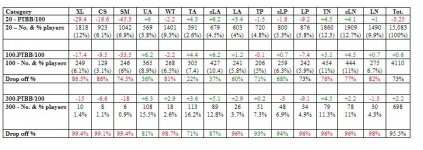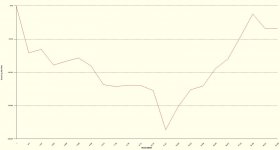Priority Categories
Now for the priority categories so-called as Poker Tracker checks its database first for these in the order set out below).
1. Xtra-loose (XL) - 55% Vp$iP or more (these are just cash machines irrespective of style).
Icon is a $ cash bag.
2. Calling Station (CS). The old favorite and still as useful as ever. Non-Tight, Passive and with a WtSD% when saw flop of > 34% .
Icon is a telephone.
3. Showdown Muppet (wins less than one in three showdowns - has to win one before rated to avoid 0/1 and 0/2 etc). You can check the actual numbers using mouse hover over the player – if it’s 1/4 you might choose to ignore it, but if its 2/10 it’s starting to really tell you something – and that something is ‘don’t worry about going to showdown with this player’! I was initially worried that by using W$SD we were just catching players who had been historically unlucky (Main New Autorate Thread) but my mind has been put at rest due to personal experience (and many anecdotal reports( of the usefulness of the category. The vast majority of the time it really does pick out players that get their money in with the worst of it. Icon is a Yellow Smiley
4. The 4th priority category is a warning signal rather than a fish finder. It's the Ultra-Aggressive
. These guys fire on every street. They have aggression 2.75+ on flop, 1.7+ on turn and 1.7+ on river.
Many good players are UA’s – see this
BTP aggression thread where the regulars post their PFA stats by street. When I first set the figures I set them higher, but had to adjust them to get enough players into this category.
You could check their WtSD$% to see how likely they are to lay down to a re-raise or if bet at. You might also check there W$SD to see if they are verging on showdown muppethood, but if the rest of their stats look decent, it best just to stay from these players without a monster hand. There are easier targets…
Icon is a bomb
5. Weak-Tight. Weak tight is basically a category of people who don’t like to see the flop all the way down to showdown. Basically they fold a lot. They see less than 13% of flops through to showdown. Overall it is a marginally losing category but it does contain players who are very canny and know when they have the best of it. Some of these players are the biggest winners in the game. Icon is a Yellow Exclamation Mark
One issue with WT is that it is one category trying to indicate 2 things
1st someone who is liable to fold if bet at on flop
2nd someone who is likely to have the goods if it gets to showdown
You can see why low WtSD% is indicative of both to some extent. We would like to split this category into 'good WT players' and 'bad./weak ones' but we don't have an extra category free..
For the moment what I am doing is having W$SD as one of the stats permanently on display and being sure to check it when I see the WT icon. Then I know what type of WT player we are playing with.
If you want to make the icon indicative of just the winning WT Players you can use the following rule instead (which was AP10's original suggestion)::
Went To Showdown % is less than or equal to 18.00
Won $ At Showdown % is between 65.00 and 99.00
Personally think there is a strong case for pushing the W$SD figure up to 67% here so you don't get a lot of 2/3 players rated in here.
Here is the category analysis table for these autorates based on AP10’s big DB. AP10’s own stats have been ignored but of course he is a winning player (+6.2PTBB/100) so he will be taking some extra money off the players listed in his DB (they are played hands rather than datamined).
They are rated for minimum 20, 100 and 300 hands played:

You will note that 'fish' (i.e. Loose Passives) aren't the worst losers anymore (as many of the worst LP losers were Xtra-loose (55%+ Vp$iP), Calling Stations or Showdown Muppets). Also those LP’s that tended to fold far too easily have ended up as the losing half of the Weak-Tight players). The ones that are left are still quite heavy losers overall but a table with just a fish or two wouldn't be enough to make me sit down. Similarly the LA’s left are small winners – but we have already taken the very loose and those that lose the most often at showdown away.
What you really want to see are the big 3 losers - XL/CS and SM's as listed above. Just one of them at the table usually covers the rake for everyone else there. I look to see an aggregate 1.5 buy-ins worth of stacks under one or more of those icons before I sit down (e.g. one CS with $150+ on a $100 table or an XL, and 2 SM’s each with $50 stacks would be fine.). Fish do lose a fair bit of cash and so I would count their stacks towards the ‘donator’ total but only at 50% of their actual stack amount.
Also more than a total of three players rated UA, TA and/or sLA would make a table less attractive to me.
Other small points to note are that sLA’s make slightly more per table than TA’s (which makes sense as they play more +EV hands at this level). However they do have a slightly higher drop out rate (perhaps more variance or more tiring style to play) and obviously aren’t able to play as many tables at once.
Drop off rate shows the likliehood that a player rated at 20 hands will make it to 100 and 300 hands respectively..
So of all players rated (15,000 or so), 391 were Tight Agressives and 1818 were Xtra-Loose (Vp$iP 55%+).
But by filtering to show those with at least 100 hands rated we can see that 86.5% of the XL players don't make it to 100+ hands rated, but 78% of TA's do make it.
By 300 hands only 1 player in 200 XL's is left, but 30% of the TA's are still hanging around.
Whilst some players will drop out because their session ends for other reasons (or because the player logging their hands ended his session) this wouldn't affect the relative drop off rate across player categories.
Folks who are losing money or bust out are more likely to drop out and that is most of the difference (there may be a small additonal factor in that tight players are just more patient as so stick around for longer, but you will notice that UA's and sLA's also show a low drop off rate)
So a low drop off rate indicates a sustainable (and most often winning) low variance strategy - and shows TA's, UA's and sLA's as the best choices.
It also indicates just how quickly the 'donator' types bust out and leave..
Higher than average drop out rates are indicated in red, lower than average ones in green.
The reason for the relatively low drop out rates of SM from minimum 20 to 100 hands is because the earliest you can be rated an SM is when you reach 1 in 4 won showdowns –so a lot of SM don’t reveal themselves until their hands logged climb up - although their bust out rate is very high (not surprising given the amounts they lose) this only shows in the 100-300 hands drop out rate.
Similarly as many players will be rated neutral/unknown initially, the drop off rates are effectively exaggerated for those 3 player types. A truer picture of the sustainability of their strategies emerges by looking at the relative drop off between minimum 100 and 300 hands.
Also note how tenacious the UA’s and TA’s are – their very low drop off rates indicate how strong styles these are over the long haul..
Incidentally of the 365 UA’s with a minimum of 100 hands played, 155 (43%) would otherwise have been TA’s, 143 (39%) sLA’s and 87 (24%) LA’s.
New Autorate Rules can be downloaded
here (you should save them as a text file to import)
Tim Rodgers has just spent a lot of time balancing these for 6-max
Six max rules are here:
6-max rules
BTP thread on the 6 max rules is
6 max thread
Autorate Rules Begin
Aggression:N
ARI_3 1 X-Loose (Vp$iP 63%+)
1 5 63.00 99.00 Vol. Put Money In Pot % is between 63.00 and 99.00
ARI_12 2 Calling Station
15 5 0.01 1.65 Aggression Factor - Total is between 0.01 and 1.65
3 5 33.00 99.00 Went To Showdown % is between 33.00 and 99.00
1 1 33.00 Vol. Put Money In Pot % is greater than 33.00
ARI_4 3 Showdown Muppet
4 5 1.00 33.00 Won $ At Showdown % is between 1.00 and 33.00
3 1 20.00 Went To Showdown % is greater than 20.00
ARI_7 4 Ultra-Aggressor
16 2 2.75 Aggression Factor - Flop is greater than or equal to 2.75
17 2 2.00 Aggression Factor - Turn is greater than or equal to 2.00
18 2 2.00 Aggression Factor - River is greater than or equal to 2.00
ARI_6 5 WT (Weak Tight)
3 5 1.00 14.00 Went To Showdown % is between 1.00 and 14.00
ARI_8 6 sLA
1 5 33.00 46.00 Vol. Put Money In Pot % is between 33.00 and 46.00
16 2 2.00 Aggression Factor - Flop is greater than or equal to 2.00
18 1 0.10 Aggression Factor - River is greater than 0.10
17 1 0.10 Aggression Factor - Turn is greater than 0.10
ARI_10 7 LA
1 5 46.00 99.00 Vol. Put Money In Pot % is between 46.00 and 99.00
16 2 2.00 Aggression Factor - Flop is greater than or equal to 2.00
18 1 0.10 Aggression Factor - River is greater than 0.10
17 1 0.10 Aggression Factor - Turn is greater than 0.10
ARI_15 8 TA
1 3 33.00 Vol. Put Money In Pot % is less than 33.00
16 2 2.00 Aggression Factor - Flop is greater than or equal to 2.00
18 1 0.10 Aggression Factor - River is greater than 0.10
17 1 0.10 Aggression Factor - Turn is greater than 0.10
ARI_2 9 Fishy (LP)
1 5 46.00 99.00 Vol. Put Money In Pot % is between 46.00 and 99.00
15 5 0.01 1.65 Aggression Factor - Total is between 0.01 and 1.65
ARI_9 10 TP (Rock)
1 3 33.00 Vol. Put Money In Pot % is less than 33.00
15 5 0.01 1.30 Aggression Factor - Total is between 0.01 and 1.30
ARI_13 11 sLP
15 5 0.01 1.65 Aggression Factor - Total is between 0.01 and 1.65
1 5 33.00 46.00 Vol. Put Money In Pot % is between 33.00 and 46.00
ARI_5 0 T N/unknown
1 3 33.00 Vol. Put Money In Pot % is less than 33.00
ARI_11 0 sL N/unknown
1 5 33.00 46.00 Vol. Put Money In Pot % is between 33.00 and 46.00
ARI_14 0 L N/unknown
1 5 46.00 99.00 Vol. Put Money In Pot % is between 46.00 and 99.00
Autorate Rules End
This article and new autorate rules copyright Andy McNish 2005
The author asserts his moral rights including the right to be identified as the author of these works.
Permission granted for non-commercial use of rules worldwide.
Permission granted for publication of this article and rules on bet-the-pot website.










